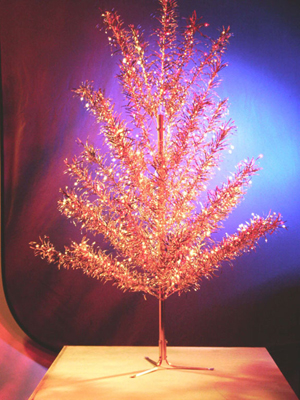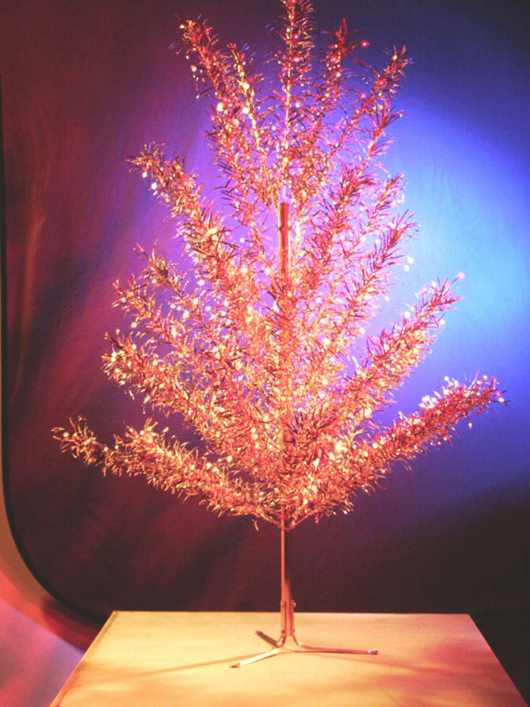
UNION, Ill. (AP) – As a child of the 1950s, Dave Harms never wanted his parents to buy an aluminum tree.
Christmas isn’t the same without a live tree, he thought. And besides, they’re just not pretty, he said.
He still thinks that way, but ironically, Harms now owns more than 40 aluminum trees.
“This is my living room,” he said as he waved his arm in front of a stage at the McHenry County Historical Society Museum in Union.
Some of his aluminum trees had been assembled in all their shiny glory, while others sat nearby piled in boxes.
They’d soon fill the stage and more at the museum, creating a forest as part of a historic winter wonderland display.
Lit by antique color wheels once used to light aluminum trees in the living rooms of the 1950s and ’60s as well as other lighting, the display takes on the feel of city lighting, Harms said.
It also includes a couple 5-foot Santas and a snowman, the plastic decorations once given away by Polk Bros. appliance and furniture stores during a four-year promotion beginning in 1962. Everyone who bought an appliance could get the free Jolly Polk Santa or snowman.
“There’s a significance for those of us who grew up with these,” said Harms of Crystal Lake. “It’s the nostalgia.”
The Aluminum Christmas Tree Forest will remain on display throughout December, available for free viewing by the public from 1 to 4 p.m. Monday through Friday at the museum, 6422 Main St., Union.
Harms has put on holiday displays at the museum for the past five years since running into Museum Administrator Nancy Fike at a post office. She was looking for holiday display ideas, and Harms had several of them.
He’s collected Christmas memorabilia since 1980, when he first set out to find a lighted tree stand like the one his grandparents used when he was a child.
They never lit it, fearing the tree stand would leak and short out the lights, Harms said.
“It just infatuated me that Grandma and Grandpa never had it working,” said Harms, who grew up in Morton Grove.
He and his family now own and run D. Hill Nursery in Union.
Visiting flea markets and antique shops, Harms eventually found the tree stand his grandparents used. He didn’t stop there. He’s collected numerous stands dating to the 1800s.
He’s been a member of Golden Glow of Christmas Past, a worldwide club for collectors of antique Christmas items, for the past 32 years.
A Rudolph fan as a child, he’s also collected numerous Rudolph antiques, such as radios, and has a wealth of Christmas books and advertising from those days. He has a Red Ryder BB Gun, made popular again in the movie A Christmas Story, as well as numerous other popular toys of the 1950s and ’60s.
“I’ve just always liked Christmas,” he said of the inspiration behind his hobby.
Using these and other items, Harms in years past has created a 1950s holiday living room, complete with a big easy chair, as well as 1950s department store and hardware store scenes for the museum.
“One afternoon, I turned off the lights and sat in that easy chair and remembered my own Christmas in the 1950s,” Fike said.
Others did the same, ascending the stage into their past and reminiscing about Christmases behind them, she said.
The popularity of 4- to 7-foot aluminum trees lasted about a decade before being phased out, said Harms, now a member of the historical society’s board of directors.
“It’s been a fun discovery,” he said of his research into the history of the trees, which came in various styles and colors.
The first patent of the trees was in 1958, when they sold for about $80. Many of the trees originated from companies in Chicago. A company in Manitowoc, Wis., figured out how to create them through an assembly line, and they soon became more affordable for everyone.
A Cary couple who once worked and met at that Wisconsin factory stopped by the museum to see the trees during a previous display, Harms said. He hopes others enjoy the nostalgia created by the displays.
He laughs as he puts together the trees, which reflect the rainbow of colors they were created in, everything from gold and silver to pink.
“In retrospect, they’re a riot,” he said. “I laugh every time I look at them. What in the world were they thinking?”
___
Online: McHenry County Historical Society, http://www.mchsonline.org
___
Information from: The Northwest Herald, http://www.nwherald.com
Copyright 2011 Associated Press. All rights reserved. This material may not be published, broadcast, rewritten, or redistributed.
AP-WF-12-11-11 1519GMT
ADDITIONAL IMAGE OF NOTE


